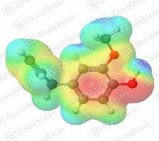Iodination of Eugenol Using Chloramine T as Oxidator http://www.doi.org/10.26538/tjnpr/v7i3.2
Main Article Content
Abstract
The activity of Eugenol in diagnosing and treating cancers has been investigated. This study aims to synthesise a Eugenol derivative by reacting it with iodide in buffer solvents at pH 5.8, 7 and 8 with chloramine T at 40 mg, 50 mg and 60 mg. The derivatives were further purified by liquidliquid extraction with aquabidest (double purified distilled water) as the polar phase and chloroform as the organic phase. The extraction was monitored with Thin Layer Chromatography (TLC) and purified with PTLC. The characterisation was done using UV and IR spectrophotometers. The product's organoleptic properties showed that it is a colourless liquid with a chloroform odour. The optimal conditions for the synthesis are pH 8 with 40 mg of chloramine T. The product showed a UV signal at ????????????????263.1 nm and the FTIR spectrum of C-I at 534.28 cm-1. In addition, the C-O band was observed at 1230.58 cm-1 and 1303.88 cm-1. The aromatic C = C at 1452.4 cm-1, 1500.62 cm-1 and 1527.62 cm-1, while C = C of an aliphatic alkene band at 1597.06 cm-1. The C-H band was observed at 3259.7 3 cm-1, while the free OH gave a signal at 3356.14 cm-1. Substituted Eugenol compounds can be derived with iodide at an optimum pH of 8 and chloramine T at 40 mg.
Downloads
Article Details

This work is licensed under a Creative Commons Attribution-NonCommercial-NoDerivatives 4.0 International License.
References
Ajvazi N, Stavber S. Electrophilic Iodination of Organic Compounds Using Elemental Iodine or Iodides: Recent Advances 2008–2021: Part I. Compounds. 2022; 2(1):3–24.
Wu T-J, Chiu H-Y, Yu J, Cautela MP, Sarmento B, das Neves J, et al. Nanotechnologies for early diagnosis, in situ disease monitoring, and prevention. In: Nanotechnologies in Preventive and Regenerative Medicine. Elsevier; 2018. p. 1– 92.
Englyst H, John C. New Developments in Dietary Fiber. 1990; (1980):205–25.
Hermanson GT. Isotopic Labeling Techniques. In: Bioconjugate Techniques. Elsevier; 2013. p. 507–34.
Islamiaty RR, Halimah E. Farmaka Farmaka. 2018;16:222– 30.
Al-Sharif I, Remmal A, Aboussekhra A. Eugenol triggers apoptosis in breast cancer cells through E2F1/survivin downregulation. BMC Cancer. 2013; 13:600.
Ghosh R, Nadiminty N, Fitzpatrick JE, Alworth WL, Slaga TJ, Kumar AP. Eugenol causes melanoma growth suppression through the inhibition of E2F1 transcriptional activity. J Biol Chem. 2005; 280(7):5812–9.
Fangjun L, Zhijia Y. Tumor suppressive roles of eugenol in human lung cancer cells. Thorac Cancer. 2018; 9(1):25–9.
Saha GB. Fundamentals of Nuclear Pharmacy. Cham: Springer International Publishing; 2018.
Levita J dan M. Radioiodinasi Pada Pembuatan Radiofarmaka. 1st ed. yogyakarta: Deepublish; 2019.
Pavia DL, Lampman GM, Kris GS, Vyvyan J. Introduction to Spectroscopy. Brooks/Cole, Cengage Learning; 2010. 655 p.


